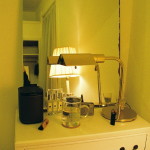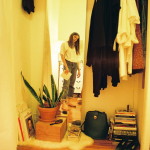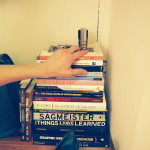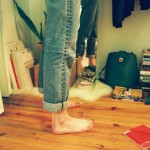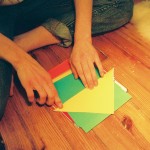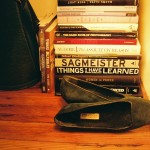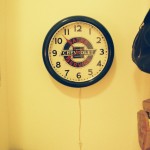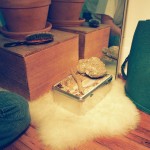It is difficult to summarize a person based off of the clothes on their back, the book in their hand or even the contents of their closet.
Today, Hazel Lewall herself helps to make up the contents of her closet. She is an accessory. She will resent the use of this word, but she is an accessory nonetheless, whom, with her short, slight stature, blends comfortably into her space.
She sits, hair freshly dried, facing a white bed that has a box spring, but doesn’t have a headboard. Her back, initially, is turned to a large for the space, but not large in general, mirror, a smart looking stack of books and a thrifted, green pair of Gucci shoes.
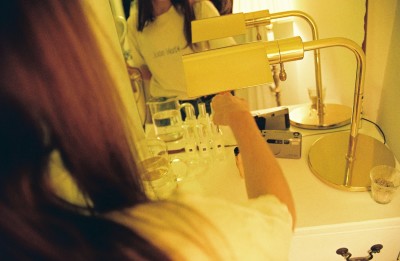
Lorde’s voice streams thickly from a Sonos speaker, a gift she received from her dad when she made Dean’s List at Parsons. Hazel pauses briefly to appreciate the bass in one of the songs. But Hazel doesn’t generally listen to Lorde. Sometimes she listens to Zero7, sometimes Tame Impala, and once High School Musical 2, but never Lorde. I share a Lorde related anecdote with Hazel and the artist’s music began to play.
The walls of Hazel’s bedroom are painted white, a choice that she had no say in, but opted not to change. In the past, she has expressed concern about the potentially damaging air quality in her West Village apartment, and it is difficult to tell if the walls are very white, or covered in a nearly imperceptible layer of soot, and simply misleadingly whiter than everything else in the apartment.
Regardless, she seems to like the color. The items on her dresser – which she painted, and is also white – are made up of three delicate looking bottles of Jo Malone perfume and something porous that she picked up on a hike with her boyfriend.
Sitting next to them is a glass filled halfway with tap water that, when one nears the sink, has been known to smell of sulfur, and a cult favorite 35mm film camera she purchased from eBay. The camera is well known for its ability to take sharp photos. This particular camera, the one sitting on Hazel’s dresser, is possibly faulty, and often, doesn’t focus.
Hazel tinkers dedicatedly with some invisible object, and then sits cross legged in the small alcove of her closet. Days later she will be careful to tell me that in my writing, I have imposed my own voice upon her. That by way of tone and concentration on the physical objects in her personal space, I have described her as someone whom she says she is not.
This someone whom I have concocted, she says, would not use the things in her own room. But Hazel in fact, appreciates practicality and prefers design and usability over decoration.
“To me, stylish is someone who works at Vogue,” she says, discounting that one should use the word when verbally illustrating her. She is not more materialistic than anyone else, or worse – arbitrarily inclined to make decisions regarding her personal style. All of this can be confirmed; though, even in her oversized men’s top from a thrift store, she is “stylish” by definition.
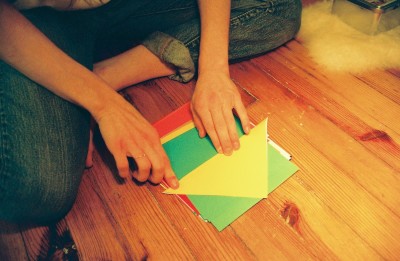
Now, one might also refer to her as being rather picky about choice of words.
“I like small spaces,” she says, not bothering to look up from the colorful origami paper she is folding. “So I took the doors off of my closet, and now it is a little alcove that I could hypothetically spend time in.” She pushes the origami away, leaving a colorful, would-be paper plane unfinished on the wooden floor. “But I just end up looking at it from my bed.”
She looks briefly into the mirror, her favorite item in the room, which she says is practical and “no frills.” Her father, who owns a construction company, attached the glass to a large piece of plywood. For Hazel, it is a mirror – nothing less, nothing more – and it serves no purpose but one. Mirroring.
In a word, Hazel describes herself as “learning.” Papers, books, and black and white photos Scotch taped onto her walls evince this. She is a lover of the cotton t-shirt and appreciates simple pieces of clothing. She often visits Salvation Army, saying that she likes not being bombarded by salespeople. Spending only a dollar on a new favorite item is a perk as well.
It isn’t that Hazel doesn’t care about how things look, she just resents anything arbitrary and everything ornamental. Her “things” all have some sort of sentiment. She wears a pair of mom jeans for example. These jeans were not pulled off of a pawed at shelf in an Urban Outfitters. In fact, they are literally a pair of jeans that at some point in time, belonged to her mother.
Tonight, they fit loosely on her thin body. She wears them most days, but when doesn’t, I imagine that they reside folded – proud, stylish and perfectly worn in, atop a gradient blue stack of denim on a closet shelf that looks like it might be too high for her to reach.
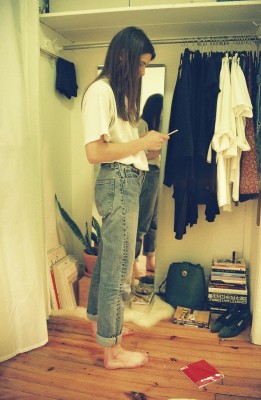
Somehow though, maybe the shelf isn’t really that high, she manages to pull them down often enough to give them daily wear.
An essentialist – one might walk into her closet and wonder where the rest of her wardrobe was – Hazel doesn’t have many unnecessary garments on display.
On hangers are several black articles of clothing that cannot be distinguished in the dim lighting, interspersed with the occasional white piece, and a single pop of color – a red, quilted dress that her mom made in an 8th grade home economics class. “She got an A in the class,” Hazel boasts, smiling.




